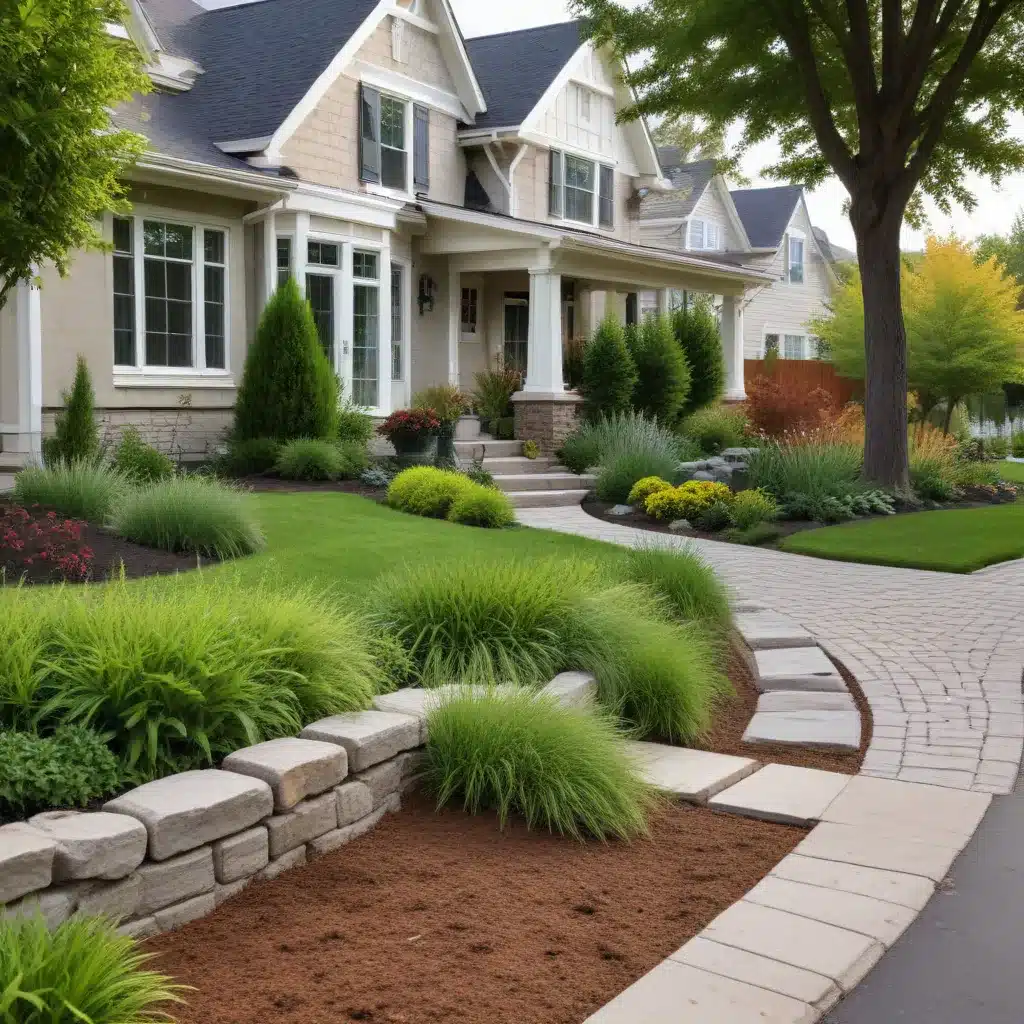
Sustainable Landscaping for Your Renovation: Eco-Friendly Curb Appeal
As an experienced home improvement consultant, I’m excited to share insights on crafting an eco-friendly yet visually captivating landscape for your home renovation. Sustainable landscaping not only enhances curb appeal but also reduces your environmental impact, lowers maintenance costs, and could even boost your property’s value. Whether you’re looking to transform an overgrown yard, create an inviting outdoor living space, or simply upgrade your home’s exterior, thoughtful sustainable design can make all the difference.
The Benefits of Sustainable Landscaping
Reduced Environmental Impact: Sustainable landscaping practices minimize water usage, limit chemical runoff, and promote biodiversity – all while reducing your carbon footprint. By incorporating native plants, permeable hardscaping, and efficient irrigation, you can create an outdoor oasis that’s in harmony with the local ecosystem.
Improved Curb Appeal: Contrary to common belief, sustainable landscaping can be just as visually striking as traditional designs. In fact, a well-planned eco-friendly landscape can enhance your home’s aesthetic appeal and increase its perceived value. With the right combination of textures, colors, and focal points, you can craft a truly captivating first impression.
Long-Term Cost Savings: While the initial investment in sustainable landscaping may be slightly higher, the long-term benefits often outweigh the costs. lower water bills, reduced maintenance requirements, and the potential for property value appreciation can all contribute to significant savings over time. As the Kanna Construction team notes, “Eco-friendly landscape designs often don’t require as much maintenance and upkeep as traditional yards.”
Choosing Sustainable Landscaping Elements
When it comes to sustainable landscaping, the key is to select elements that work in harmony with the local environment. This often translates to using drought-tolerant native plants, implementing water-efficient irrigation systems, and incorporating permeable hardscaping to reduce runoff.
Native Plant Selection: Choosing plants native to your region is a game-changer for sustainable landscaping. These species are naturally adapted to the local climate and soil conditions, requiring less water, fertilizer, and maintenance than non-native alternatives. By incorporating native flora, you can create a visually appealing and low-maintenance landscape that supports local pollinators and wildlife.
Water-Efficient Irrigation: Overwatering is a common issue in traditional landscaping, leading to wasted resources and higher utility bills. Sustainable irrigation systems, such as drip lines or smart controllers, can deliver water precisely where it’s needed, minimizing evaporation and runoff. Some homeowners even explore rainwater harvesting or graywater recycling systems to further reduce their reliance on municipal water supplies.
Permeable Hardscaping: Instead of traditional impermeable surfaces like concrete or asphalt, consider using permeable pavers, decomposed granite, or natural stone for your walkways, patios, and driveways. These materials allow water to infiltrate the ground, reducing stormwater runoff and promoting groundwater recharge. This not only benefits the environment but can also help mitigate flooding and erosion issues.
Incorporating Renewable Materials
Sustainable landscaping extends beyond plant selection and water management. Incorporating renewable materials into your hardscaping and softscaping can further enhance the eco-friendly credentials of your outdoor space.
Sustainable Hardscaping Options: Explore options like recycled concrete, natural stone, or permeable pavers for your patios, walkways, and retaining walls. These materials have a lower environmental impact than traditional hardscaping alternatives, and they can also add unique textures and visual interest to your landscape design.
Eco-Friendly Softscaping: In addition to native plants, consider drought-tolerant groundcover, pollinator-friendly flowering species, and organic mulch to nourish your soil. These softscaping elements not only contribute to a beautiful, low-maintenance landscape but also support local ecosystems and promote soil health.
Sustainable Lawn Alternatives
While traditional grassy lawns can be a cornerstone of many home landscapes, they often require significant water, fertilizer, and mowing. Sustainable lawn alternatives can provide a lush, low-maintenance solution that aligns with your eco-friendly renovation goals.
Low-Maintenance Grass Options: Native grasses, clover, and even artificial turf can offer a visually appealing and environmentally friendly alternative to traditional lawn grasses. These options require less water, reduce the need for mowing and chemical treatments, and can still provide a soft, inviting surface for your outdoor living areas.
Edible Landscaping: Consider incorporating fruit-bearing trees and shrubs, vegetable gardens, and herb beds into your landscape design. Not only do these elements contribute to a sustainable, self-sufficient lifestyle, but they can also add unique visual interest and personal touches to your outdoor space. Integrating integrated pest management techniques can help you maintain a healthy, chemical-free edible landscape.
Enhancing Curb Appeal Sustainably
Sustainable landscaping isn’t just about environmental benefits – it can also significantly enhance your home’s curb appeal and functionality. By incorporating thoughtful design elements, you can create an outdoor oasis that’s both aesthetically pleasing and environmentally responsible.
Functional Landscaping Features: Incorporate sustainable features like rainwater harvesting systems, composting stations, and strategically placed outdoor living spaces to seamlessly blend form and function. These elements not only contribute to your home’s eco-friendly credentials but can also provide practical benefits and unique visual interest.
Aesthetic Considerations: Carefully curate your landscape design to achieve a harmonious, visually striking result. Play with complementary color schemes, layered textures, and focal points to create a captivating first impression. The end goal is to craft an outdoor space that not only aligns with your sustainability values but also sparks joy and inspiration for all who see it.
As you embark on your sustainable landscaping journey, keep in mind that every home and homeowner is unique. Work closely with a reputable landscape designer or eco-conscious general contractor to develop a customized plan that meets your specific needs and preferences. With the right approach, you can transform your outdoor space into a true showcase of eco-friendly curb appeal.



